Spooky pentagram and concentric circles are among 20 carvings found at haunted 15th century manor house that is said to be home to the ghost of the Grey Lady
A pentagram, concentric circles and a name written upside down.
A pentagram, concentric circles and a name written upside down.
Put together, they sound like part of the plot of a horror novel.
But these spooky symbols have been uncovered at a haunted medieval manor house that was once visited by King Henry VIII and his fifth wife, Catherine Howard.
Around 20 carvings dating back to the 16th century were found at Gainsborough Old Hall, in the Lincolnshire market town of the same name.
The discoveries also included six-petalled flowers within a simple circle - known as daisy wheels and hexafoils. Such symbols were believed to trap demons.

Also found was a pentagram, which despite its association with the occult, was originally used to protect against evil

Around 20 carvings dating back to the 16th century were found at Gainsborough Old Hall, in the Lincolnshire market town of the same name
Others include overlapping Vs, which are known as Marian marks and are believed by some to call on the Virgin Mary for protection.
The carvings were found by English Heritage volunteer Rick Berry over the course of two years, the charity revealed today.
Many of the marks were found in the servants wing of the building.
Given its association with the occult, the discovery of the pentagram might unsettle some.
But the symbol was originally used to protect against evil.
The research also revealed rare curse inscriptions, which, although they must have been made when London merchant William Hickman owned Gainsborough Old Hall from 1596, are more commonly associated with the Roman and Anglo-Saxon period.
In one inscription, Hickmans name is written upside down. The practice of defacing a name was believed to curse the named person.
Such an example has never been seen at an English Heritage site.
Gainsborough Old Hall is said to be haunted by the daughter of its original 15th century owner, Thomas Burgh.
Elizabeth Burghs spirit, which is referred to as the grey lady has allegedly stalked the corridors ever since she allegedly died after being locked away by her father when he discovered her plans to marry a lover of lowly status.

Concentric circles found on a wall at Gainsborough Old Hall in the market town of the same name in Lincolnshire

In one inscription, the name of Gainsboroughs Old Halls then-owner, William Hickman, is written upside down. The practice of defacing a name was believed to curse the named person

The discoveries included overlapping Vs, which are known as Marian marks and are believed by some to call on the Virgin Mary for protection

English Heritage volunteer Rick Berry seen holding a torch to one of his discoveries at Gainsborough Old Hall
Hickman was not a popular man and was called a threadbare fellow by one critic.
A protestant, he was supportive of local preachers who deviated from the established Church.
As well as the carvings, there are around 100 burn marks, which were once believed to protect against fire.
Put together, the various symbols make Gainsborough one of the most protected sites in English Heritages 400-strong portfolio.
Gainsborough Old Hall dates back to the early 15th century. It was the seat of the Burgh family from 1430.
The manor was inherited by trusted royal courtier Thomas Burgh II from his mother in 1455.
Burgh served four kings, including Edward IV and Henry VII. In 1487 he was made the first Lord Burgh by Henry.
When Burgh II died in 1496, the estate was inherited by his eldest son, Edward.
However, Edward fell into debt and was accused of being involved in plots against the King. He was eventually declared insane.

London merchant William Hickman owned Gainsborough Old Hall from 1596

This writing scrawled onto a wall at Gainsborough Old Hall is yet to be deciphered

Writing on a wall at Gainsborough Old Hall that is still in need of deciphering
King Henry VIII stayed at the property in 1541, when it was in the ownership of Thomas III
Gainsborough Old Hall remained the seat of Burgh family until 1596, when it was sold to the Hickman family, who lived there until around 1730.
Kevin Booth, English Heritages head of collections, said: It is astonishing that centuries on the amazing old buildings in our care still have secrets waiting to be discovered.
The Old Hall has undoubtedly had a tumultuous past, not least under the ownership of the apparently unpopular William Hickman, but why its the scene of quite such a high concentration of protective carvings remains a mystery.
We have a great team of volunteers across the country and it is testament to Ricks passion for the place that these incredible protection marks have been found at Gainsborough.









